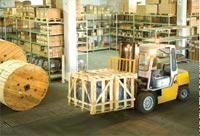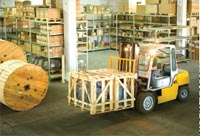
Control of Propane-Powered Forklift Truck Emissions
- By D. Jeff Burton, PE, CIH
- Feb 01, 2008
 In future columns I will answer questions posed to me related to the engineering control of occupational health and safety hazards. Please contact me at [email protected] with your questions.
In future columns I will answer questions posed to me related to the engineering control of occupational health and safety hazards. Please contact me at [email protected] with your questions.
Question: One of our forklift truck operators recently complained of headache. I think he might have been overexposed to carbon monoxide (CO). We took that truck out to be serviced. So I'm interested in the general control of propane-powered tailpipe CO emissions and exposures. Currently, we have one of these trucks running around our warehouse about 50% of the time. Our warehouse has a volume of about 300,000 cubic feet (empty of storage). Dilution ventilation consists of two fans in the roof exhausting about 5,000 cfm each, with makeup air entering through the service doors on the north and south ends of the building. Is this adequate? What should we be doing to avoid over-exposures to CO and do it in a cost-effective way? -- T.H.
Answer: There are countless "war stories" of CO over-exposure for drivers when such vehicles are improperly tuned, operated in confined spaces, used without sufficient dilution ventilation, etc. For typical stories, go to: jama.ama-assn.org/cgi/content/full/283/3/331. The current thinking on propane-powered indoor forklifts, trucks, etc, seems to be:
• They always emit CO (e.g., about 0.4% of the tailpipe exhaust) when "tuned."
• Poorly tuned, such vehicles can emit a lot more CO -- up to 10% or more.
• It is not unusual for such engines to be out of tune. In a study, "Carbon Monoxide Hazards from Internal Combustion Engines" (Michigan OSHA), it was reported that over half the forklifts tested were above 5% CO and a few were even above 10%.
• CO concentration measurements (e.g., tailpipe and driver) should be made regularly (even daily, under some circumstances).
Emission and exposure controls must include engineering and administrative measures. I describe some of the more common approaches here.
Administrative Controls. Because CO is colorless, tasteless, and odorless and because indoor air concentrations may rise quickly even in relatively open spaces with ventilation, resulting over-exposures may cause adverse health effects and employees may have trouble seeking safety. Therefore, it is important that you train employees to recognize sources of CO and the initial warning signs of CO poisoning• light-headedness, dizziness, nausea. and/or headache.
In addition, employees who use or work around fuel-powered equipment indoors should be made aware of the medical attention that may be required (e.g., victims should be removed from the exposure and given oxygen, call 911, etc.).
Engineering Controls. One useful approach is to substitute electric-powered trucks for propane and eliminate the CO source. Cost comparisons can be provided by suppliers and manufacturers.
If you stay with propane-powered trucks, here are some suggested control approaches.
Follow manufacturer recommendations. Contact your propane-powered truck supplier or manufacturer who can tell you what they recommend or require for CO controls, tuneups, testing, ventilation, etc. You should, at a minimum, follow their instructions.
Provide adequate dilution ventilation. The 26th Edition of the ACGIH Vent Manual (Vol. 1, Section 13) recommends the following dilution rates:
• 10000 cfm/propane-fueled lift truck
• 16000 cfm/gasoline-fueled lift truck
• 10000 cfm/operating automobile
• 20,000 cfm (or more)/operating truck
• 100 cfm/horsepower for diesel-fueled vehicle
These dilution rates assume a regular periodic maintenance program that limits CO concentrations of gases to 1 percent for propane-fueled trucks and 2 percent for gasoline-fueled trucks. These rates also assume vehicles are only used for half of the work day, there is good distribution of airflow, space volume is greater than 150,000 cubic feet/lift truck, and trucks are powered by engines of less than 60 HP. If operating conditions vary from these assumptions, the ventilation rate should be increased significantly. (See the Manual for more information.)
Required dilution ventilation rates can also be estimated from the following formula:
Q = q x Km x 10^6/C
Where
Q = dilution air volume flowrate, cubic feet per minute (uncontaminated air)
q = emission rate of CO in exhaust gases, cubic feet per minute
Km = poor air mixing factor, unitless; usually assumed to be 1.5 to 4, depending on local factors (e.g., storage impeding airflow, etc.)
C = acceptable exposure concentration, ppm; usually some percentage of an OEL (e.g., 10 to 50 ppm)
Sample Calculation:
• one propane-powered forklift truck
• average tail-pipe exhaust rate = 25 cfm [Note: Please don't use this sample exhaust rate for any genuine estimates. Actual rates vary widely.]
• percentage of operating time = 50% distributed evenly throughout the shift
• tailpipe CO concentration ("slightly out of tune") = 2%
• C = 25 ppm
• Km = 1.5 (assumes fair mixing)
q = 25 cfm x 0.02 = 0.5 cfm CO (2% of the total tailpipe exhaust rate)
q (average) = 0.5 cfm x 0.5 = 0.25 cfm [assuming 50% operating time]
Q = q x Km x 10^6/C = 0.25 x 1.5 x 10^6/25 = 15,000 cfm
Under these conditions, your exhaust rate of 10,000 cfm (two fans) would not be sufficient. Note that 10,000 cfm in your warehouse is an air exchange rate of about two air/changes per hour. |
Provide regular maintenance and tuning. To achieve good vehicle performance while maintaining low CO emissions, vehicle engines should be in good working condition and properly maintained. Employers should tune vehicles using an exhaust gas CO analyzer to limit CO emissions to the minimum. Tuning fuel-burning equipment to limit CO emissions can be accomplished with minimal reduction in power.
Specifically, periodic maintenance tuning for engines should include:
• Use properly-sized carburetors designed for optimum air and fuel mixture balance.
• Service the air cleaner regularly.
• Adjust engine timing per manufacturer's specifications.
Use a CO analyzer designed for tailpipe exhaust sampling to adjust the fuel system to approximately 0.4 to 0.7% CO.
Consider catalytic converter removal of CO. A catalyst converts CO and unburnt hydrocarbons into carbon dioxide and water vapor. They require regular maintenance because overloading of the catalyst will reduce its efficiency. The combination of a catalytic converter and a properly tuned engine is thought to be able to achieve tailpipe CO emissions below 200 ppm.
Cost Considerations. Lowering CO saves fuel and operating costs. Because fuel economy is optimal when CO is near 0.5%, concentrations above this will waste fuel. A forklift with an average CO concentration of 7% can waste 700 gallons of fuel per year. With fuel costs at $4 per gallon, the user could save about $2,800 per year.
Additional Measures. The NIOSH publication "Alert: Preventing Carbon Monoxide Poisoning from Small [Fuel-Powered] Engines and Tools," makes the following recommendations for employers and equipment users:
• Substitute less hazardous equipment (e.g, electric vehicles).
• Do not allow the use of gasoline-powered equipment inside buildings or partially enclosed areas unless adequate ventilation is provided.
• Recognize the signs and symptoms of CO overexposure.
• Use personal and area CO monitors equipped with audible alarms to warn workers when CO is excessive.
• If an employee has symptoms, turn off equipment and go outdoors. Call 911 for medical attention
• do not drive a motor vehicle.
In addition, the NIOSH Alert recommends equipment manufacturers and rental agencies:
• Place warning labels on gasoline-powered tools.
• Tell customers the equipment should not be used indoors.
• Have portable, audible CO monitors available for rent or purchase and encourage their use.
• Provide recommendations for equipment maintenance to reduce CO emissions.
This article originally appeared in the February 2008 issue of Occupational Health & Safety.